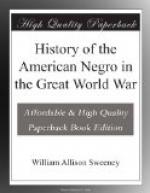It has been noted that the first Negro combatant regiment to reach France was the celebrated National Guard organization known as the 15th New York Infantry, rechristened the 369th when made a part of the 93rd division of the United States army. This was such a well drilled and equipped regiment that early in the war it was permitted to go across with the first 100,000; all of which was due to the aggressiveness and insistence of its white commander, Colonel William Hayward. He simply gave the war department no rest, stating that he was willing his men should unload ships, fell trees and build docks or cantonments so long as they were permitted to sail.
The regiment had been organized by Colonel Hayward at the suggestion of Governor Whitman of New York. It was to be patterned after the 8th Illinois where colored men of means sufficient to support commissions, were the officers. The regiment was started in June 1916 and by October had 1,000 in the ranks. Colonel Hayward was the only white officer, the Negro commission-holders at that time being Captain Marshall, Captain Fillmore, Lieutenant Lacey, Lieutenant Reed and Lieutenant Europe. The latter was attached to the Machine Gun section but became later the famous musician of the outfit. He was the only Negro officer who remained with the regiment throughout, the others being superseded or transferred after several months service in France.
Early in 1917, the Federal government said it would recognize the regiment if it could muster fifty-one officers. As recruiting had been slow and a Negro regiment in New York was looked upon as an experiment, Colonel Hayward was obliged to secure the needed officers from among his friends in the 7th New York, the Motor Battery, Squadron A and other organizations. By this time the enlisted strength had grown to 1,200. On April 8, 1917, two days after the United States entered the war, the regiment was inspected by Federal officers and a week later was recognized as a regular unit of the Federal Guard.
But, as the Colonel expressed it, they were a “street urchin of a regiment.” They had no armory, no place to drill except in the open and no place where more than a single company at a time could meet. In his post-war observations, the Colonel has noted that when the regiment returned to these shores and was feasted and entertained by the people of New York in the 71st regiment armory, it was the first occasion on which the old 15th was ever assembled under one roof.
After its Federal recognition the regiment was sent to the Peekskill rifle range to learn to shoot, a valuable experience as developed later. Many of the boys became expert marksmen, a skill that became of precious value to them and their comrades.
In June, 1917, they went to a war strength of 2,000 men and 56 officers. One battalion did pioneer work at Camp Upton, another at Camp Dix. A third guarded 600 miles of railroads in New York, New Jersey and Pennsylvania. The Machine Gun company guarded 2,000 interned spies and pro-German prisoners at Ellis Island. Colonel Hayward has pointed with pride to the fact that in all their territory there was not a wreck, an explosion, an escaped prisoner or any other trouble. Two battalions later went to Spartanburg for training, but remained there only a couple of weeks.




